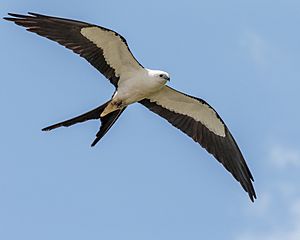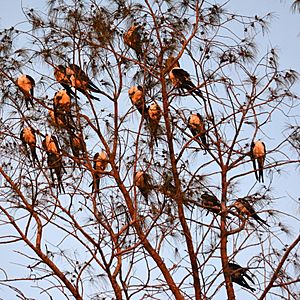Swallow-tailed kite facts for kids
- For the African species sometimes known as African swallow-tailed kite, see scissor-tailed kite
Quick facts for kids Swallow-tailed kite |
|
|---|---|
 |
|
| Conservation status | |
| Scientific classification | |
| Genus: |
Elanoides
|
| Species: |
forficatus
|
| Subspecies | |
|
|
 |
|
| Distribution: Year-round Breeding Migration | |
| Synonyms | |
|
Elanus forficatus (Linnaeus, 1758) |
|
The swallow-tailed kite (Elanoides forficatus) is a beautiful raptor. It is known for its graceful flight and unique forked tail. This bird lives in the southeastern United States, Central America, and parts of South America.
Many swallow-tailed kites fly south for the winter. They travel from North and Central America to South America. Some populations in South America stay there all year long. It is the only species in its group, called Elanoides.
Contents
About the Swallow-tailed Kite
How it Got its Name
The swallow-tailed kite was first described in 1731. An English naturalist named Mark Catesby called it the "swallow-tail hawk." He also used a Latin name meaning "forked-tail hawk."
Later, in 1758, Carl Linnaeus gave it the scientific name Falco forficatus. The name Elanoides was added in 1818. This name comes from ancient Greek words meaning "kite" and "resembling." It perfectly describes this bird that looks like a kite.
What Does it Look Like?

The swallow-tailed kite is a medium-sized bird. It is about 50 to 68 centimeters (20 to 27 inches) long. Its wingspan can be as wide as 1.12 to 1.36 meters (3.7 to 4.5 feet).
These birds weigh between 310 and 600 grams (11 to 21 ounces). Both male and female kites look very similar. Their bodies are a striking mix of deep black and white.
The top of their wings, tail, feet, and bill are all black. The underside of their wings is partly black and partly white. A special feature is their long, forked tail, which is 27.5 to 37 centimeters (11 to 15 inches) long. This tail looks like a swallow's tail, giving the bird its name.
Young swallow-tailed kites are not as brightly colored as adults. Their tails are also not as deeply forked.
Where They Live and How They Behave
Swallow-tailed kites often live in large wetland forests. These forests provide good places for them to build their nests. They often choose tall loblolly pines for nesting. If pines are not available, they might use bald cypress trees.
The most important things for nesting sites are enough food and tall trees. Nests are often built in trees that are as high as 30 meters (100 feet). In the United States, their habitat used to cover many southern and midwestern states.
Today, their range in the U.S. has shrunk. It is mostly found in coastal areas of the southeastern and southwestern U.S. This change is due to habitat loss and changes in wetlands.
Amazing Migrations
Swallow-tailed kites are migratory birds. In the spring, they fly thousands of miles from Central and South America to breed. They travel to coastal wetlands in the Americas to find the best nesting spots.
Researchers use Satellite tracking to follow individual birds. Some kites have been tracked on journeys longer than 16,000 kilometers (10,000 miles). Losing forests and habitats along their migration routes is a concern for these birds.
These birds are known as some of the most graceful fliers in America. They spend most of their lives soaring high above treetops. They look for food like lizards, small mammals, and insects. Their unique wing and tail shape helps them glide easily for long distances.
Swallow-tailed kites usually do not make much noise. Sometimes, they let out a high-pitched chirp.
What Do They Eat?
The swallow-tailed kite eats small reptiles, such as snakes and lizards. They also eat small amphibians like frogs. Large insects, such as grasshoppers and crickets, are also part of their diet.
Sometimes, they eat small birds and eggs. They even eat small mammals, including bats. In Central America, they have been seen eating fruit. When they drink, they skim the surface of the water. They collect water in their beak without stopping their flight.
Life Cycle and Reproduction
Swallow-tailed kites usually mate between March and May. The female bird lays 2 to 4 eggs. The eggs are kept warm for about 28 days until they hatch.
The young birds stay in the nest for 36 to 42 days before they are ready to fly. It is thought that these birds form pairs for mating. They might spend time apart but meet up again for migration and nesting.
Their nests are often built in the tallest trees in wetland areas. Sometimes, pairs will return to the same nesting spots each year. They will fix up their old nests. Building a new nest usually takes about four days.
Protecting the Swallow-tailed Kite

The United States government does not list swallow-tailed kites as endangered. However, some states have them listed as needing protection. For example, they are listed as endangered in South Carolina. They are threatened in Texas and considered "rare" in Georgia.
The main reason for the decline in their numbers is the destruction of their habitats. Places like the Lower Suwannee National Wildlife Refuge in Florida are important for their protection.
Good habitat restoration and management efforts have helped. Since 2016, their populations seem to be stable and even growing. These efforts have helped the birds re-establish nesting populations in parts of Georgia, Florida, and South Carolina.
Images for kids
See also
 In Spanish: Elanio tijereta para niños
In Spanish: Elanio tijereta para niños





